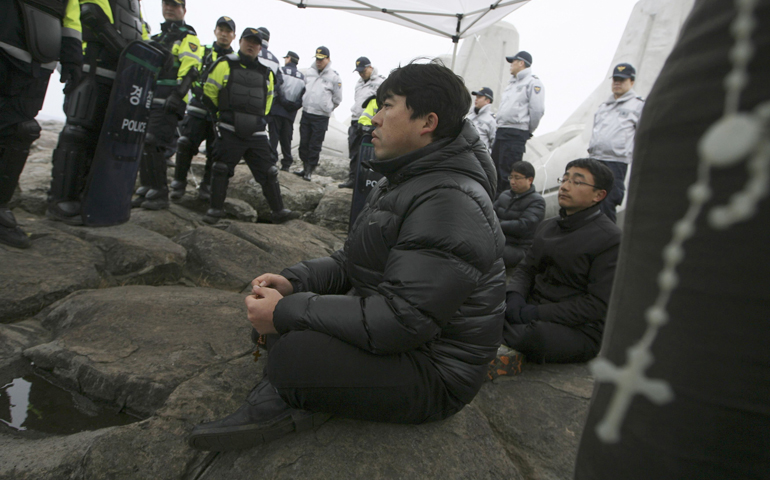
A priest prays the rosary as policement surround him and other clergy holding a sit-in protesting construction of a new naval base on Jeju Island, South Korea, in March 2012. (CNS/Reuters/Lee Myung-ik)
Traveling through South Korea for five days, Pope Francis will be hard pressed to meet local challenges. He will be called to offer greater meaning to the nation's young people plagued by consumerism, fresh hope to its economically marginalized, encouragement to tired peacemakers, and reconciliation within a fragmented society seemingly searching for a 21st-century identity and a path forward.
To help achieve these daunting ends, he will reach into Korean history, calling upon a people's revered martyrs, citing their special spirit and faith, to kindle, mold and exalt a refreshed Korean Catholic soul.
Beneath the widespread anticipated excitement and programmed pageantry, every ounce of Francis' personal charm, knack for breaking with official form, and ability to articulate a no-nonsense, Gospel-based faith will be required for his journey to have a lasting impact.
This is the first time Francis will leave his Western comfort zone, working through a distant language. High clergy in Korea and Rome have largely choreographed his day-to-day activities, to the disappointment of many ordinary lay Catholic Koreans, who will be watching carefully for indications that beneath it all, Francis is one of them.
As he hops from city to city Aug. 13-18, he will mingle with Koreans whose psyches have been darkened by the memories of their drowned children, victims of likely neglect and greed. The April 16 MV Sewol ferry disaster, which took the lives of 300, haunts Koreans.
Francis will be called upon to offer both salve and meaning. On a wider scale, he will need to supply direction for people who have burst into wealth but whose neighborhoods, towns and villages are plagued by growing gaps between rich and poor.
It will be Francis' third international outing of his 17-month pontificate. By all indications, he will be received warmly. While South Korea is only 10 percent Catholic, it is perched on Confucian respect for authority and shamanist appreciation for gods and religion.
The Korean peninsula, which includes both North and South Korea, is mountainous. While Koreans are a homogenous ethnic group, many have lived in relatively isolated pockets, leading to strong regional identity. It has been said that if the Korean landmass were ironed flat, it would stretch across China, Korea's neighbor. China, meanwhile, has shaped Korean culture, exporting Buddhism and Confucianism.
Korean indigenous belief is foundational and comes in the form of a 5,000-year-old shamanism in which male and female priests connect the spirit world with the lives of ordinary people. Even today, shamanistic rituals continue in Korean life. The construction of a modern skyscraper can begin with shamanist rituals calling for protection and success.
South Korea, like most other Asian nations, is trying to navigate through turbulent times as its sacred past confronts the fast pace of a modern techno-driven, secular, consumer society.
The South Korean economy, meanwhile, has exploded in recent decades. It's now ranked eighth in the world in disposable income. But with great costs: Economic gains have not been evenly distributed, adding to political tensions.
In the last two decades, the gulf between rich and poor has expanded dramatically. One 2012 report showed the top 10 percent of the South Korean population possesses nearly half the nation's wealth while the bottom 50 percent struggle, holding only 10 percent of those riches.
Coming out of the 2008 global financial meltdown, these trends have only moved toward greater inequity.
South Korea today provides a living canvas upon which Francis can highlight his calls for reaching out to those on the extremities of society.
As in other Asian countries that prize tradition, fast social change has placed generation against generation as they struggle to communicate their very different experiences to each other. Porting cellphones while meeting in shopping malls, younger Koreans can feel unmoored at times, having jettisoned many of the securities of centuries of tradition. Reaching these souls and delivering meaningful, memorable words will not be easy.
Cloud over youth day
One of the highlights of Francis' visit will be the time he spends with young Catholics celebrating the sixth Asian Youth Day in the city of Daejeon Aug. 15. As wildly joyful as that gathering is likely to be, it will take place under the cloud of the ferry sinking. Of the 300 who died, most were secondary school students -- children looking much like those who will surround Francis during hours of song, dance and prayer. Given recent findings of corporate greed and failure of government oversight as causes leading up to the accident, the collective Korean psyche has been wounded. Answers must be found for healing to take place. How Francis balances the joy and sorrow will be watched carefully through Korea and beyond.
One stated reason for Francis' voyage is the beatification of 124 martyrs. Some of these martyrs helped grow the faith as it took roots in the 19th century. Pope John Paul II canonized 103 Koreans in 1984, during one of his two visits to the country. Francis will move others in this direction.
Unlike other Asian countries, such as the Philippines and Vietnam, where people encountered Catholicism for the first time by means of missionaries living alongside colonial enforcers, the Korean laity first sought out and built the earliest Christian communities. Clergy were latecomers to the scene. This is a fact that lay Koreans sometimes like to remind their clerical brothers, who today are largely revered in a still highly structured Korean society.
History records that in 1784, a man named Yi Seung-hun was baptized while living in China. He later returned to his home in Korea, carrying various religious texts while baptizing other Koreans. Christian communities formed and grew without missionary priests, until French clergy arrived in 1836.
The 19th century saw periodic Christian persecution. During that time, some 8,000 Catholics are said to have been put to death for their faith. Among these will be some beatified by Francis during his visit.
The Catholic church in South Korea has witnessed significant growth in recent years. Catholicism has jumped from 1.5 million in the 1980s to 5.5 million today. This represents 10.4 percent of the South Korean population. While there are more than 8 million Protestants, their numbers have declined in the past 15 years.
Meanwhile, no one knows the precise numbers of Catholics living in North Korea. Some estimates place the numbers from a few thousand to 10,000 or more.
Peace and reconciliation
One important pastoral theme for Francis' visit will be peace and reconciliation. Koreans are a proud people whose history goes back millennia, but it is dotted with conflict, religious persecution and war.
Today the North and South Korean capitals of Pyongyang and Seoul are only 120 miles apart -- a distance that represents ethnic, economic and political division.
For most of the world's population, the Korean War of the early 1950s lives on with a mention in world history books. Not so on the Korean peninsula, where war continues to shape political discourse and economic life.
To better understand the scar of the Korean War, one might recall it took the lives of more than a million South Koreans, another million North Koreans, hundreds of thousands of Chinese military, and 36,500 U.S. soldiers. The conflict never officially ended. Hostilities were put on hold with an armistice agreement in July 1953.
South Korean Catholics have invited their brethren in the North to participate in the papal visit, but whether any can cross the 2,200-yard demilitarized zone that separates the nations remains to be seen.
Some 28,500 U.S. troops are still based in South Korea, providing it a relatively economical military umbrella. Their presence is generally favored, polls show. However, U.S.-South Korea military projects have not always been acceptable to many Koreans, including, at times, Catholics.
A recent flare-up has involved the South Korean government's decision to build a naval base on an island off the southern coast. Jeju Island is a pristine piece of land, an "ecological jewel," as it has been described. The construction of the base has infuriated local villagers, who have been among the project's most vocal opponents. Korean peace activists, including many Catholics, have aided them. Demonstrations have halted building efforts more than a half-dozen times.
The Jesuits and Columban missionaries have joined Korean bishops, religious and laity in daily prayers at the main naval gate. There have been more than 700 arrests and dozens have been carted off to jail for their protests.
Peace activists see a U.S. hand in these matters. They claim one reason for the base is to house U.S. naval vessels and to project U.S. military strength against neighboring China.
The Korean bishops are on record opposing the base construction. "We don't need this base," Bishop Peter Kang U-il of Jeju said, echoing the voices of his episcopal brothers. "It is essential that the naval base plan be abandoned, for the sake of Jeju residents and the whole of the Republic of Korea."
Korean Catholic peace activists earlier this year wrote Francis urging him to come to the island and join them in their daily Mass during his visit. They were disappointed after learning their petitioned visit was not on his itinerary.
"The pope cannot visit everyone who extends an invitation," Bishop Mario Toso, secretary of the Vatican's Pontifical Council for Justice and Peace, said at a news conference in Seoul.
Toso added, "Pope Francis' visit is intended to make South Korea's churches rise and shine on the world."
Some view the petition and subsequent denial as a measure of Francis' limitations within church bureaucracy. His itinerary was formed through visits by Vatican bishops to South Korea, where they met with their episcopal brethren. The Catholic Bishops' Conference of Korea, like other Asian bishops' conferences, is more conservative than it was in the past, and less willing to confront government policies.
Also on the Francis program will be time spent with the disabled. He is scheduled to visit the House of Hope rehabilitation center in Kkottongnae, or the "Flower Village," in Seoul, which has 2,000 residents. But this visit has stirred some controversy. While supported by the Korean bishops, Kkottongnae is viewed as out of touch with contemporary ideas on treatment of the disabled. Community-based, integrated models are seen as preferable to institutions that gather and inadvertently segregate, as Kkottongnae does.
On his final day in South Korea, Francis will stress the need for peace and reconciliation at a Mass in Seoul's Cathedral of the Immaculate Conception, also known as the Myeongdong Cathedral. A subtext to this Mass involves an invitation extended to the Korean "comfort women" who were forced to work at Japanese military brothels during World War II. Estimates of the numbers of these women have run from 20,000 to 200,000 or more. Only a relative few of these women remain alive today. They continue to demonstrate each Wednesday in front of the Japanese embassy in Seoul.
The issue remains highly charged in Asia seven decades after the war's conclusion and has symbolized divisions between the Japanese and other Asian peoples. Korean and Chinese women made up most of the ranks of these sex slaves. Meanwhile, their governments have been unsuccessful in obtaining compensation from the Japanese.
The gothic Seoul cathedral has played a prominent role in Korean history, serving as a refuge for political protesters in the 1960s and 1970s during some of the most repressive days of military dictatorship.
Those protests and the asylum given to protesters by the late Cardinal Stephen Kim Sou-hwan earned the Catholic church high marks in Korean society, which some say has led to the burst in Catholic growth.
[Thomas C. Fox is NCR publisher and the author of Pentecost in Asia: A New Way of Being Church. He can be reached at tfox@ncronline.org.]


